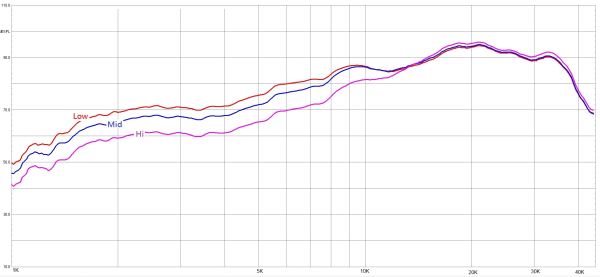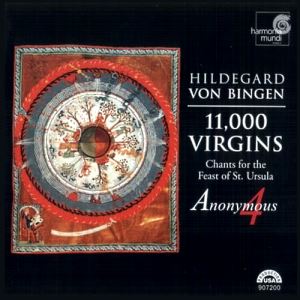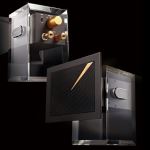
Twenty years ago I went shopping for a new pair of loudspeakers. At the time, there were no hi-fi shops close by. The best I could do was one dealer, who carried Thiel and Vandersteen, about 60 miles in one direction, and another dealer, who carried Thiel and MartinLogan, about 40 miles in the other direction. I visited both, and ultimately decided on Thiel. (In retrospect, the Vandersteens probably would have been the better choice, but that is another story.) Not that it was the deciding factor, but I remember thinking that, in addition to speaker cables, I was going to have to get some long extension cords if I selected the MartinLogans, because they required AC power to energize their electrostatic stators, and there were no convenient outlets where I wanted to site the loudspeakers. It is kind of ironic because a few years after that I moved on to a Meridian system which, of course, required power cables in addition to digital cables to connect everything up, and I didn’t even blink. Probably because my new home was built in the 20th century and had outlets everywhere.
Imagine my surprise at CES 2012 when I walked in the ENIGMAcoustics room and saw the avant-garde design Enigma Finale ($50,000/pair) concept loudspeakers with electrostatic tweeters. Not a power cable in sight. Huh? Wei Chang explained to me that the tweeters were SBESLs (self-biasing electrostatic loudspeaker), a proprietary process his company had developed through which they were able to permanently implant charges on a non-conductive film with a special molecular structure serving as charge holder, and thereby dispense with the need to be constantly powered. In addition to a permanently charged membrane, they also designed the stators out of rigid, copper-clad fiberglass, minimizing thickness, maximizing openness, and increasing rigidity to reduce vibration inducing distortion. For their work, they were awarded a CES Innovations Design and Engineering Award. For CES 2013, they separated the tweeters from the Enigma Finale loudspeakers and reintroduced them as the Sopranino super tweeters, and another CES Innovations Design and Engineering Award followed. I was able to get a lengthy demo of the Sopranino’s at the T.H.E. Show at Newport Beach in May, and was so impressed I requested a review pair.
The Sopraninos arrived in a non-descript corrugated cardboard box. Inside, however, I found a velvet-lined, pearwood box containing the Sopraninos themselves. Talk about an awesome out of the box experience. The Sopraninos are an elegant combination of glass and aluminum. For lack of a better term, the stand portion is a vertical glass rectangle, into which the aluminum horn-shaped horizontal electrostatic element is inserted using an elastomer material. At the rear of the glass housing are a switch marked 0 and -3 (corresponding to 90db and 87db sensitivity for speaker matching), a rotary knob to set the crossover frequency at 8,000Hz, 10,000Hz or 12,000Hz, and a pair of WBT 7063 speaker binding posts (which accept both spades and bananas) for connection either to your main speakers or directly to your amplifier. The frequency response of the Sopranino’s at the different crossover settings is shown below.

First a confession. When I was auditioning the Sopraninos at T.H.E. Show, I placed my ear next to them and couldn’t hear anything with the Magico V3s playing at the same time. Nevertheless, the Sopraninos were clearly having an effect on the sound. Hmmm. Though, like most men my age, I am the victim of presbycusis, I also have been very careful with my hearing, and know I can hear past 12,000Hz because I had my hearing checked a couple of years ago before I began reviewing (12,000Hz was the limit of my audiologist’s test equipment). So I was a little nervous when I first set up the Sopraninos. What if I couldn’t hear anything in my setup? It was with some trepidation then that I initially connected the Sopraninos without the main speakers in play, switched their level to -3db and the crossover to 12,000Hz, returned to the listening position, and pressed Play. To my great relief, at normal volume levels, I could easily hear the contribution of the Sopraninos, though I must admit it was modest. Whew!
Setup was straight forward. I had two pairs of speakers on hand - the Sony NA2ESes I had just finished reviewing here and my reference Magnepan 1.7s. The Sopranino’s simply rested atop the NA2ESes. For the Magnepan 1.7s, I placed them on top of a pair of adjacent Target HR speakers stands situated at ear level. Since I didn’t have an extra pair of my reference Kimber Select KS6063 speaker cables, I called into service a pair of Mogami 3103 speaker cables with Audioquest BFA connectors, which I connected to the second set of speaker binding posts on my amplifier. I also took some bulk Mogami 3103 and soldered up a a heavy-duty double-pole, single-throw switch at one end and some more Audioquest BFAs at the other so I could turn the Sopraninos on and off from the listening position for quick comparison, which I found indispensable in accurately assessing the effect of the Sopraninos in my system.

I tried them first with the Sony NA2ESes. Now the NA2ESes are not likely candidates for super tweeters. They already have a three tweeter I-Array and high frequency extension out to 45,000Hz (-10db), mirroring the extension of the Sopraninos. What would be the result of inserting them in the system? I cued up Brahms’s String Quartet in A minor, Op. 51, No. 2 performed by the Alban Berg Quartet on EMI. It is a live recording. I flipped the Sopraninos off and on and was hard pressed to tell any difference. It was only when I left them on for a while, and then switched them out, that differences became apparent. The first give-aways were the applause at the beginning and end of the work, as well as the pauses between the movements when some shuffling was heard. In each case, a slightly larger space was apparent when the Sopraninos were on. It is not as if the soundfield collapsed when the Sorpaninos were taken out of the equation; it was more on the order of a slight contraction. The second area of change was in the strings, where the leading edge of the transients were sharpened slightly. The net effect was a bit more pristine presentation. Not a day and night difference, mind you; rather one you had to pay careful attention to hear.

I next put on a disc I knew to have an enormous space - Hildegard von Bingen’s 11,000 Virgins: Chants for the Feast of St. Ursula performed by the a capella quartet Anonymous 4. Again, with the Sopraninos on, there was a slight increase in the ambiance of the venue and clarity in the presentation. Unless you engaged in concentrated listening and had the ability to switch the Sopranino’s in and out, I doubt the differences would have been detectable. Switching the crossover point down from 12,000HZ to 10,000Hz and 8,000Hz made the effects somewhat more pronounced. Switching the Sopranino’s from 90db (which is the same sensitivity as the NA2ESes) to 87db took the Sopraninos out of the equation all together. Which says a lot about the already stellar high frequency performance of the Sony NA2ES loudspeakers, as well as the ability of the Sopraninos not to call attention to themselves. In other words, they do not change to overall character of the loudspeakers they supplement.
The Magnepan 1.7s are a different kettle of fish - a bi-polar quasi-ribbon design instead of the dynamic drive configuration of the Sony NA2ES. In addition, their high frequency response is specified only out to 24,000Hz, meaning the Sopraninos extend their frequency response to over 40,000Hz. Much to my surprise, when playing back the same selections, I could tell no difference with the Sopraninos switched in or out, regardless of sensitivity setting or crossover point. I also moved the Sopraninos from the outside to the inside of the 1.7s, and moved them slightly closer and further away, with the same result. I have no real explanation for why I would hear the difference with the Sony NA2ESes but not the Magnepan 1.7. I suspect a couple of things, however. First, I am certain I can’t hear beyond 24,000Hz, so the additional high frequency extension of the Sopraninos for the Magnepan 1.7s (and the Sony NA2ESes) was immaterial for me. Second, the high frequency dispersion patterns for the Magnepans and the Sonys are much different from one another, and that the benefit of the Sopraninos for the NA2ESes was related to dispersion.
How then to explain to marked difference that I heard at CES 2013 and T.H.E. Show, that was less evident with the Sony NA2ESes and missing altogether with the Magnepan 1.7s in my listening room? There are two obvious answers: 1) expectation bias, 2) the high frequency extension and dispersion patterns of the Magico V3s ENIGMAcoustics used in its demonstrations were not up to the level of those of the Sony NA2ESes and the Magnepan 1.7s. My guess is that it was a little of both. Which underscores that the benefit of the Sopraninos, if any, in your system will be dependent on the performance of your reference loudspeakers, and, at least to some extent your room, and any acoustic treatments you may have deployed. Your hearing ability with respect to high frequencies will also play a role. I wish I had had several more pairs of loudspeakers, with less high frequency extension and more narrow dispersion than either the Magnepan 1.7s or Sony NA2ESes, on hand to conduct a more comprehensive set of listening tests. I suspect that the Sopraninos would work their magic more noticeably on them (at least for my ears). They certain did for the Magico V3s.
Conclusion
There is no questions that the Sopraninos work as advertised, increasing leading edge transients, microdynamics, and spatial imaging. Whether the difference would be meaningful for you would be dependent on your hearing, your speakers, and your room, meaning a personal audition in your system is a must. Then there is the question of cost. At $3690, the Sopraninos are not exactly pocket change (well, at least for some of us). At what price point of your main speakers would it make sense to pass on the Sopraninos and simply purchase a higher quality pair of speakers? Quite the financial balancing act. I would suggest that, if you think you are missing that last bit of air or ambiance, and are otherwise happy with the overall balance of your speakers, you give the Sopraninos a try under ENIGMAcoustics home trial program, either through a dealer or, if one is not nearby, then through ENIGMAcoustics directly. Nothing ventured, nothing gained. The Sopraninos may prove to be just the ticket to take your system to the next level, or the final touch on an already great system.
- Frank Berryman
Specifications
• Nominal impedance: 4 ohm
• Sensitivity (1m/2.83V): 90dB with 0/-3dB switch
• Crossover frequency : 8/10/12 kHz
• Crossover slope: -12dB/oct.
• Frequency response: 8kHz-40kHz(+/- 3dB)
• Recommended input power: 50W
• Dimensions (WxHxD): 7.13″ x 7.60″ x 8.15″ (181mm x 193mm x 207mm)
• Weight (Net): 6 lbs. / 2.7 Kg
• Weight (Shipping): 27 lbs. / 12.3 Kg
Contact
ENIGMAcoustics
11 Chrysler
Irvine, CA 92618
Telephone: (949) 340-7590
www.enigmacoustics.com
[email protected]
Associated Equipment
Analog Source: VPI Scout; Dynavector 20X2; Musical Surroundings Phonomena II
Digital Sources: Meridian G08; Mac Mini; dCS Debussy; Audirvana Plus
Preamplifier: Meridian G02
Power Amplifiers: Pass Labs XA100.5
Loudspeakers: Magnepan 1.7; Sony NA2ES
Analog Cables: Kimber Select KS1016 and KS1116
Digital Cables: Kimber Select KS2020 and KS2416 USB
Speaker Cables: Kimber Select KS6063 and KS9033
Power Cables: Kimber PK10G and PK14G
Headphones: Etymotic ER-4S
Accessories: Audience aR2p power conditioner


